A Dream of Post Post-Processing
Yes. I'm returning to rant again on my favorite pet peeve: the never-say-die stink surrounding post-processing. I know some of you feel this is a dead issue. We all get along now...
...except we don't. The old biases just keep cropping up.
From "Recent Evolution in Fractal Art" from Ken Keller's site:
I consider the definition of Fractal Art to mean images that are originally produced with a computer program that is dedicated to fractal image generation. It is also assumed that minimal post processing is applied to the final, presented image. Layered fractal images are categorized as Fractal Art, but not images that are collage type images using other than fractal image elements (such as 'put a pretty girl in front of a fractal' ). Layered fractals are produced by many fractal generation programs and each layer is indeed a genuine fractal.
Keller might "assume" such limitations, but I refuse them. It's big of him to give a program like Ultra Fractal a thumbs up allowing hundreds of collaged layers the benefit of still being minimally post-processed. Each layer, he claims, is still a fractal -- even if the final composite is smushed together like hash and stacked like mashed-up pancakes. Anything goes, apparently, as long as the manipulation properly occurs inside the fractal software. Export your fractal out -- and, well, you're out -- or out of control. Moreover, it doesn't matter how much filtering firepower is built directly into one's fractal software. Ultra Fractal can do animations. XenoDream can do lighting effects similar to software by Flaming Pear. Filters come standard in both Fractal Explorer and Fractal Forge. Do each of these onboard adjustments still use only "fractal image elements"?
And let's hear from Chasm -- described by Joseph Trotsky as "the master of artistic post-processing":
It is my opinion that fractal pp will remain fractal art, as long as the pp has not ruined the original fractal patterns. Chasm has described it in a most beautiful and clear way: "I was pleased insofar that I've managed to preserve the original fractal contour and much of the coloring, and not ruin the image in a filter-frenzy."
Trotsky and Chasm are much more radical than Keller. They actually believe the fractal artist can wander outside of the (ahem) parameters of the fractal-generating software. But don't stray too far from home. That way a filter-frenzied madness lies -- even if Photoshop filters do run by using algorithms. Trotsky calls extensive post-processing "fractal abuse" and "fractal vandalism." Only if the forms are preserved can the art remain "fractal" rather than catch-all "digital" -- obviously an inferior iteration allowing infestations like "black smears" to cloud otherwise serious art. And, whatever else you do, don't ever alter the original fractal forms. They are sacrosanct. Go too far, and you've crossed an artistic line drawn in the sand by those who've been touched by God (or math -- a lower case god) to be gifted enough to discern such fine distinctions.
Even the popular fractal art contests once run through Fractalus seemed to share a similar sensibility. Here is a bit of the "Post-Processing Statement" from the 1999 contest:
One of the limitations fractal artists accept is that the medium -- visual representations of mathematical formulas -- imposes some restrictions on the creative process. Producing beautiful images despite the restriction is part of the challenge and beauty of fractals.
If you choose to process your image, that is OK as far as the rules are concerned. But you should keep in mind that the more obviously you alter the image, the less pleasing it is likely to be to some of those who vote. The key word you should remember is enhance. We're not really interested in who can apply the most complex filter combinations in Photoshop to produce something barely recognizable as a fractal. We're interested in great fractal pictures.
One wonders, given the image manipulation features now pre-built into programs like UF and XenoDream, if the pictures produced today would have seemed "barely recognizable as a fractal" back then.
So, what's my problem with all of the above?
For one, I don't like limitations on making art -- especially when the restrictions seem designed to benefit some fractal artists while punishing others.
For another, if everything above represents the current fractal art canon -- and I believe it probably does -- then I've been permanently banished outside the castle walls.
Let's get a couple of things straight.
Making a fractal is not the same as making art. Anyone can make a fractal. In fact, anyone can make about twenty in less than a minute using a program like Fractal ViZion. Does that make one an insta-artist? No. I can stand in my backyard with a digital camera, spin in circles, and snap the shutter randomly. I may be taking pictures. I am not, however, making art. Fractal art is not exempt from the longstanding characteristics that define visual art: composition, depth, perspective, texture, and so on. I hate to be the bearer of bad news but that quickie render you just slapped up on Renderosity might not really be a masterpiece. Fractals have to be made with more than math and craft to become art. If not, they are just fractals -- just empty snapshots of the backyard.
Furthermore, every fractal artist post-processes. No exceptions. If you've changed your fractal from its initial iteration and removed it from the generator, you've altered it. Use image compression? Unsharp mask that sucker? Add a signature or frame or watermark? Upload that baby to the web to float in HTML? You're guilty of post-processing.
And even...did you layer upon layer that poor thing in UF? Guilty. Juan Luis Martinez explains why:
We say a fractal image has been post-processed when it has been imported into a graphics editor to adjust any of its original properties. That results in a modification of the master picture as it came out of the fractal generating software alone. This is a normal practice in digital graphics creation, but still divides the group of fractal artists in two camps: those who prefer to leave the fractal as is (keeping its natural form) and those that routinely enhance its appearance with the intent of improving or increasing the artistic output. Ultra Fractal helped to change that perception because most fractal artists are using it almost exclusively, unleashing its power to combine several layers into a single image. Since all adjustments are done inside the same application, some people think they're not post-processing the picture, but the truth is that all those operations are altering the base image, equaling what will normally be post-processing.
So, the only questions about post-processing then are how and how much.
Apparently, if you believe the poobahs, using your fractal generator, no matter how extensive its built-in manipulation functions, is cool. You are still and always will be a legit fractal artist. But export your fractal to another graphics program and begin flailing away, well, you've somehow cheated. Or, worse, you're ignorant. You failed to read the rule book and follow the universally understood (even if arbritary) limitations.
And how convenient is it that the most expensive fractal software also has the most post-processing capabilities? No wonder I used to see something like this tagged to posted images at on-line fractal communities: Made with UF. 100 layers. No post-processing. Who are you kidding? You bludgeoned that thing within an inch of its pixels! But you've manipulated nothing because you've miraculously remained within the (self-imposed) limitations and kept your extensive collaging activities strictly inside UF? I bet I could export each of those layers into Paint Shop Pro, mush them together, and come up with something wildly close to what you did.
The limits thing? I understand that, I guess -- up to a point. On my web site, I describe my own work as "fractal-based digital art." But, frankly, I think that's what UF makes, too. I'm wondering if these fine distinctions matter less to me than they do to others. I'm more interested in breaking out the art part of fractal art -- not making bonds tighter. I'll blow up the fractal forms if I like the effect. I'll post-process a fractal to the point where code words like frenzy don't begin to cut it. I'll do whatever it takes to drag that fractal lake and dredge the art out of my fractals. In a variation of the Vietnam paradox about saving villages, sometimes I have to destroy the fractal in order to save it.
And, however much I atom-smash the stalks and spirals out of my images, when you strip away all the multiple layers and many adjustments, you end up with the original parameter file.
Just like that very first fractal made in UF way back when by somebody somewhere before everyone else decided to pile on.
~/~
Here's a demonstration of my point.
Let's roll some footage:
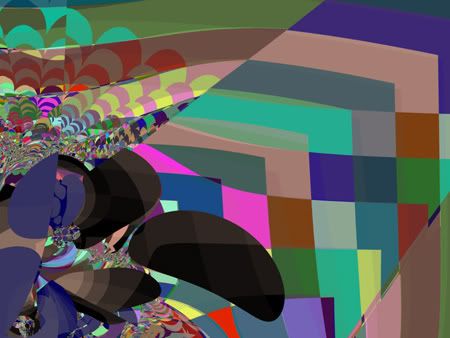
Here's a fractal made in FraSZle. I tweaked it a bit in the generator (but I guess that's okay). I used it as a base for this:
The Last Bee (2007)
I thrashed this one every which way possible -- but the fractal forms are still relatively intact. Did I cheat? Or was I going about trying to make art from what I initially saw as a backyard picture?
Here's lower right corner detail from the first render:
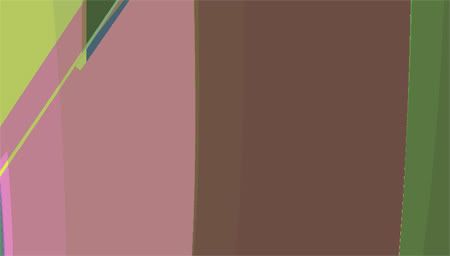
And here's lower right corner detail from the finished image:
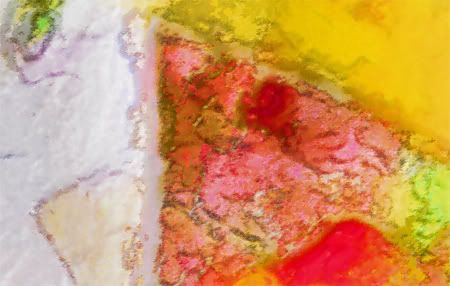
Did I go too far? Was I merely "revising"? Or just using the colors and textures to highlight the overall arrangement? In short, was I exercising artistic control? Or was I committing the sin of "post-processing"?
Here's another case. I warn you though. Don't stray far from the fainting couch. This one probably constitutes "fractal vandalism."
Here is the base image from FraSZle
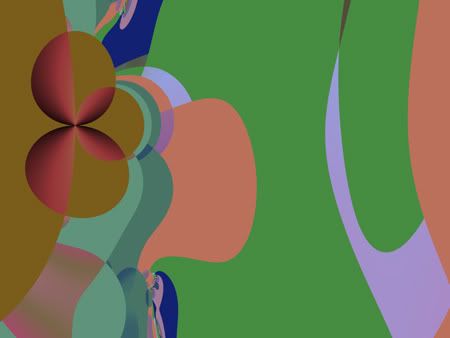
and it somehow became this:
Evolution Impulse (2007)
Uh-oh. Break out the smelling salts. Somebody colored outside the lines.
~/~
So what do I want?
I want these distinctions and limitations lifted. Given that so much manipulation can now be done in so many fractal programs, I want all post-processing bias put down for good. No more pulling the stake out of its heart so it can wander undead in the night and drain fractal artists of their freedom to punch through artificial boundaries. I'm tired of knocking at a fractal contest door and having it slammed in my face. I don't like being told I'm not playing by rules I think are nonsense and that are deliberately designed to repress creativity and artistic freedom. And I'm fed up with people claiming their programs get a bye for fractal purity but mine do not -- especially since both are now doing much the same thing in the same ways. And, finally, I'm tired of reading drivel like this -- seen on a DeviantArt fractal contest held last year:
Post processing using an image editing program such as Photoshop, or Paint Shop Pro is allowed as long as the focus of the image is a fractal.
Oh yeah. We wouldn't want the focus of an art contest to actually be on the art.
Didn't you get the memo?
~/~
Rooms with a View
Blog with a View
Technorati Tags: fractal, fractal art, fractal programs, digital art, post processing, ultra fractal, xenodream, purity
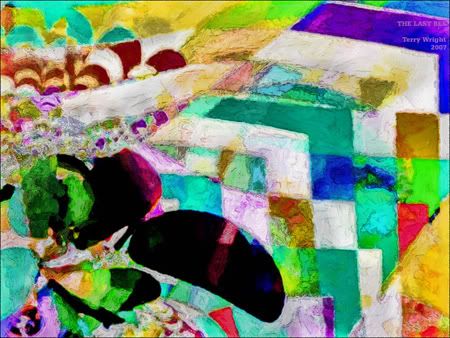
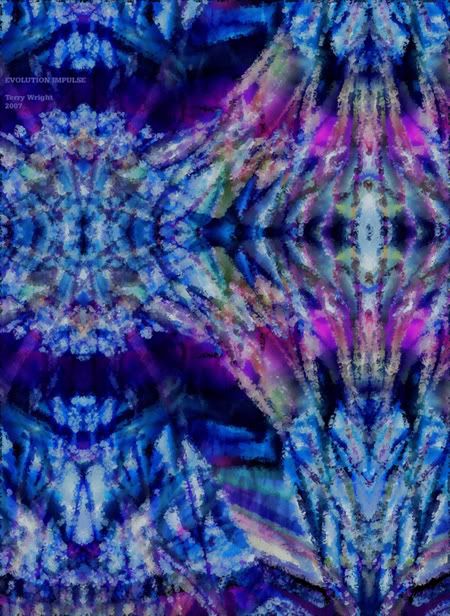




1 Comments:
I must agree.
For example, the initial base images you inserted do nothing for me, but the post-processed images are much more pleasing and interesting, at least to my eye.
I think we might say "Fractal Artists" may be divided into two camps: mathematicians who dabble in art, and artists who dabble in mathematics. (I consider myself the latter.) True, this might be over-simplifying things, but the thought just popped into my head while reading the above post.
7/05/2007 12:07 AM
Post a Comment
<< Home